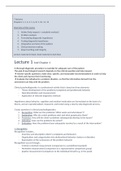Samenvatting
Psychological Assessment (500196-B-6): Summary of book and lectures
- Vak
- Instelling
- Boek
This summary contains both the lectures and the chapters of the book for the course Psychological Assessment (-B-6)! Lectures 5 and 6 are not included, as they are guest lectures without any clear-cut study material. Book: Psychological diagnostics in health care, ISBN: 8276
[Meer zien]













